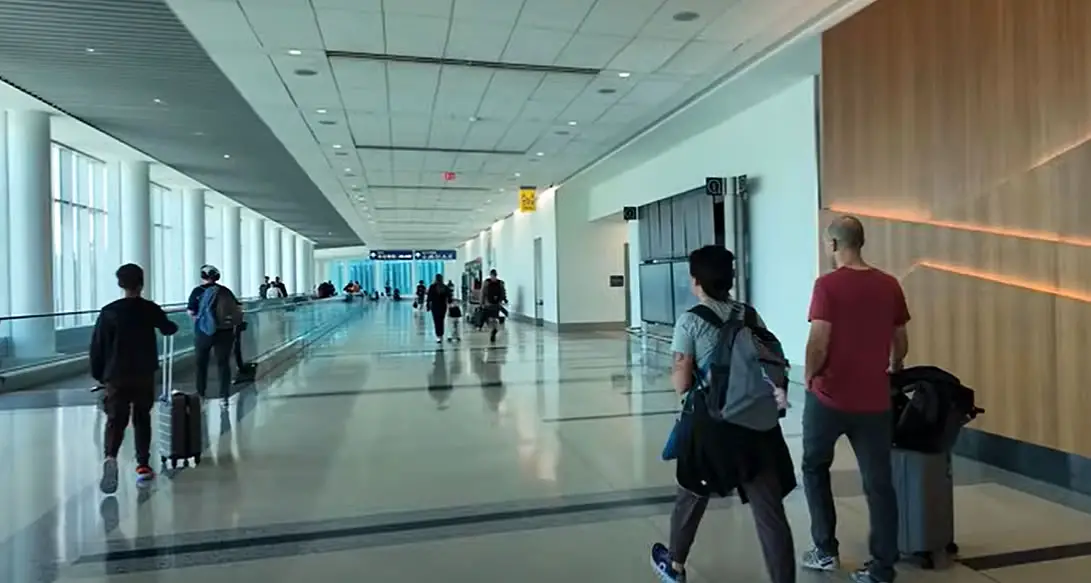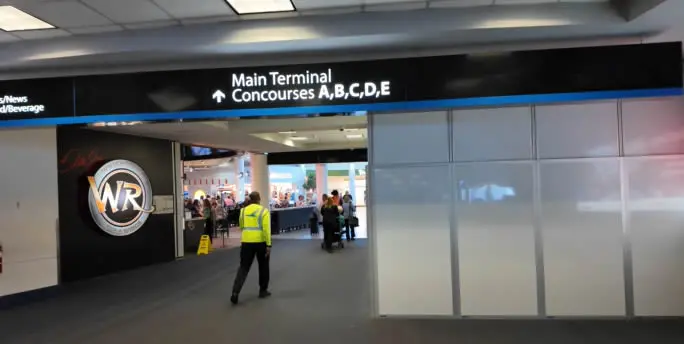Visitors intending to reach the official website should click HERE
CLT Main Terminal and Concourses

What to Expect When Navigating Charlotte Airport 🛬
- 🛫 How many boarding areas does CLT have? Five concourses (A, B, C, D, and E) connected to a single main terminal.
- 🚗 How do you get from parking to the gates? Free 24/7 shuttle buses run between long-term lots and the main terminal.
- 🚶♂️ Are there internal trains? No. All travel is on foot. There are moving walkways, but they are frequently out of service.
- 🧶 Is it accessible for seniors or individuals with reduced mobility? Only partially. Several elderly passengers report difficulties due to long distances and a lack of seating.
- 🏠 Can you rest between flights? Only if you find a seat. Several concourses lack sufficient seating, especially during peak hours.
- 🛁 Is the airport clean? It depends on the area. Some restrooms are spotless; others, especially in Concourses B and C, are reported as dirty or closed.
Details on the layout, composition, and the challenges faced by passengers, such as congestion and lack of seating, based on real experiences.
Charlotte Douglas International Airport (CLT) is one of the busiest in the United States. It consists of a main terminal and five concourses: A, B, C, D, and E. These are connected to the central building, which houses ticketing, security checkpoints, and baggage claim areas. Despite the internal connection, passenger experiences vary widely, with feedback ranging from praise for its efficiency to criticism for its inefficient design.

Image from YouTube
🏢 Between Parking Lots and Concourses
Transportation between parking lots and concourses operates 24/7. Shuttle shelters are located in Long-Term Lots 1 and 2, Daily Decks, and the Express Deck (Preferred). On return, buses are boarded in the inner lanes of the lower level (Arrivals/Baggage Claim).
🚷 Congestion and Lack of Seating
One of CLT's biggest pain points. Passengers frequently report having to sit on the floor due to a lack of seating, especially in Concourses B, C, and E. In Concourse E, for example, "there's nowhere to sit or walk without bumping into others." This is exacerbated during delays, when overcrowding leads to even emergency exits being used for resting.
🛀 Long Distances and Accessibility
The journey between concourses can take 15 to 30 minutes. There are no trains or motorized carts for passengers. Many criticize the lack of assistance for people with reduced mobility and the absence of handrails or benches in long corridors. Moving walkways are frequently out of service.
⚒️ Ongoing Renovations
Improvement works have been ongoing for years, generating both anticipation and frustration. Concourse E, for example, has been under renovation for over two years. Users complain about confusing signage, blocked paths, and uninformed staff. Some areas like the central atrium have improved (with new dining and relaxation zones), but others remain impassable.
🚪 Connections within the Airport
Between concourses: The journey from Concourse E to Concourse A can take up to 30 minutes. The design aims to facilitate pedestrian movement but does not adequately accommodate the current passenger volume. Some describe the transfer as "a marathon."
From parking lots: The shuttle service covers all main shelters, but delays can occur during peak hours. The boarding area is well-marked.
🏛️ Main Terminal
- Level 1: Baggage Claim and tunnels to the rental car center and parking.
- Level 2: Check-in and security. There are three checkpoints.
- Level 3: USO Lounge, chapel, nursing rooms.
Many consider that "the main terminal has become too small." During peak hours, queues and noise make it difficult to navigate. However, details like the rocking chairs or large windows are highly valued.

Image from YouTube
🏥 Concourses A to E
Concourse A: 32 gates (A1-A13 nearby, A21-A39 further out). Good signage but frequent security lines.
Concourse B: 16 gates. Features an Admirals Club. Packed during peak hours, some describe it as "crowded and dirty."
Concourse C: 18 gates, exclusive to American Airlines. Very congested. Criticized for lack of seating and space.
Concourse D: 13 gates. International flights. TSA here is very slow and poorly organized, according to several users.
Concourse E: 45 gates. Criticized for long distances, ongoing construction, and inappropriate behavior by some employees.
🛬 Customs and TSA
- Checkpoint 1: 3:30 AM - 10:45 PM
- Checkpoint 2: 3:30 AM - 7:45 PM
- Checkpoint 3: 4:30 AM - 8:45 PM
The efficiency of these checkpoints varies depending on the time of day. Many travelers report congestion, especially at Checkpoint 3 (international). Some comment that "the post-Global Entry signage is so confusing that the benefit loses its meaning."
🚨 TSA PreCheck and Global Entry
CLT has dedicated TSA PreCheck lanes at Checkpoints 1 and 2. The enrollment center is in the main atrium, past security. Those approved receive a Known Traveler Number to use PreCheck at any airport.
Additionally, CLT participates in Global Entry, which expedites U.S. entry for pre-approved travelers. The enrollment center operates Monday to Friday (1:00 PM to 8:00 PM) in the baggage claim area. There is also an Enrollment on Arrival option in Concourse D.
Users appreciate these services, but indicate that local efficiency "is not on par with other airports."
📄 Conclusion: The Good, The Improvable
CLT is a vital hub in the eastern U.S., with good connectivity and a wide dining selection. However, it faces critical challenges: overcrowding, poor facility maintenance, and an insufficient internal transport system. The rocking chairs, natural light, and some restaurants redeem the experience. But for many, it remains a functional but less-than-friendly airport for tight connections.
For updated information, consult TSA, Global Entry, and the official CLT website.
